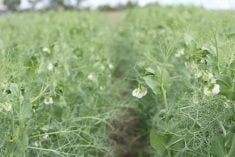The president of the Flax Council of Canada thinks the industry will have no problem meeting Agriculture Canada’s 600,000 tonne export forecast for the 2010-11 crop.
“If the stocks are there, those numbers are quite possible,” said Barry Hall.
His confidence is buoyed by a surprising 2009-10 marketing campaign that saw 772,000 tonnes of exports, up 21 percent over the previous year despite the CDC Triffid incident that rocked the industry.
“A year back, no one would have ever anticipated those numbers,” said Hall.
Read Also

Fendt takes a combine on the road in the U.S.
Putting an Ideal combine in fields across different regions has given the brand a chance to prove that the combine is capable of performing well in a variety of conditions.
China was the saviour, buying 245,000 tonnes, up from 71,000 tonnes the previous year.
Perhaps the bigger surprise was that Europe was still the top buyer. It imported 271,000 tonnes, down from about 430,000 the year before but still enough to lead all buyers despite implementing an onerous protocol to ensure no GM flax makes the trip overseas.
Hall thinks exports to Europe will continue to be steady, perhaps in line with last year’s volumes. But those sales will not go on the books without considerable challenges and risks.
“I wouldn’t want to give anybody the impression that the problem has been solved. It is still very difficult to meet all the criteria that are required to get cargoes out that meet the protocol.”
Europe still insists all Canadian flax shipments be extensively tested to ensure they contain no more than 0.01 percent Triffid. Hall doesn’t anticipate them budging off that stance anytime soon.
He said it is anybody’s guess what will happen with China this year.
“Flax prices have increased fairly significantly and of course that always throws a bit of a shock into the marketplace,” he said.
If it wasn’t for China mopping up what Europe didn’t buy, flax prices would be nowhere near today’s levels, which are well above the pre- Triffid levels.
Hall said the bigger market question this year is what Canada will have for supply. Statistics Canada’s September estimate was 537,000 tonnes of production, down 42 percent from last year.
“It won’t be any higher than that,” he said.
The production estimate is based on an average yield of 21.5 bushels per acre.
In its Oct. 11 crop report, Saskatchewan Agriculture reported yields ranging between 17 and 23 bu. per acre. There are some reports of frost damage causing high green seed counts in harvest samples.
Hall said it is too early to gauge the level of Triffid contamination in this year’s crop. It may take another two or three weeks of testing to get a bead on that. The industry implemented more stringent and costly testing procedures this fall.
“Everybody is not happy with that but we’re trying to make every effort to reduce the risk,” said Hall.















